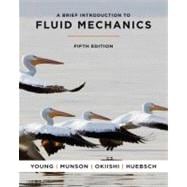
Note: Supplemental materials are not guaranteed with Rental or Used book purchases.
Purchase Benefits
What is included with this book?
1.1 Some Characteristics of Fluids.
1.2 Dimensions, Dimensional Homogeneity, and Units.
1.3 Analysis of Fluid Behavior.
1.4 Measures of Fluid Mass and Weight.
1.5 Ideal Gas Law.
1.6 Viscosity.
1.7 Compressibility of Fluids.
1.8 Vapor Pressure.
1.9 Surface Tension.
1.10 A Brief Look Back in History.
1.11 Chapter Summary and Study Guide.
2. Fluid Statics.
2.1 Pressure at a Point.
2.2 Basic Equation for Pressure Field.
2.3 Pressure Variation in a Fluid at Rest.
2.4 Standard Atmosphere.
2.5 Measurement of Pressure.
2.6 Manometry.
2.7 Mechanical and Electronic Pressure-Measuring Devices.
2.8 Hydrostatic Force on a Plane Surface.
2.9 Pressure Prism.
2.10 Hydrostatic Force on a Curved Surface.
2.11 Buoyancy, Flotation, and Stability.
2.12 Pressure Variation on a Fluid with Rigid-Body Motion.
2.13 Chapter Summary and study Guide.
3. Elementary Fluid Dynamics-The Bernoulli Equation.
3.1 Newton?s Second Law.
3.2 F = ma Along a Streamline.
3.3 F = ma Normal to a Streamline.
3.4 Physical Interpretation.
3.5 Static, Stagnation, Dynamic, and Total Pressure.
3.6 Examples of Use of the Bernoulli Equation.
3.7 The Energy Line and the Hydraulic Grade Line.
3.8 Restrictions on the Use of the Bernoulli Equation.
3.9 Chapter Summary and Study Guide.
4. Fluid Kinematics.
4.1 The Velocity Field.
4.2 The Acceleration Field.
4.3 Control Volume and System Representations.
4.4 The Reynolds Transport Theorem.
4.5 Chapter Summary and Study Guide.
5. Finite Control Volume Analysis.
5.1 Conservation of Mass?The Continuity Equation.
5.2 Newton?s Second Law?The Linear Momentum and Moment-of-Momentum Equations.
5.3 First Law of Thermodynamics?The Energy Equation.
5.4 Chapter Summary and Study Guide.
6. Differential Analysis of Fluid Flow.
6.1 Fluid Element Kinematics.
6.2 Conservation of Mass.
6.3 Conservation of Linear Momentum.
6.4 Inviscid Flow.
6.5 Some Basic, Plane Potential Flows.
6.6 Superposition of Basic, Plane Potential Flows.
6.7 Other Aspects of Potential Flow Analysis.
6.8 Viscous Flow.
6.9 Some Simple Solutions for Laminar, Viscous, Incompressible Fluids.
6.10 Other Aspects of Differential Analysis.
6.11 Chapter Summary and Study Guide.
7. Similitude, Dimensional Analysis, and Modeling.
7.1 Dimensional Analysis.
7.2 Buckingham Pi Theorem.
7.3 Determination of Pi Terms.
7.4 Some Additional Comments about Dimensional Analysis.
7.5 Determination of Pi Terms by Inspection.
7.6 Common Dimensionless Groups in Fluid Mechanics.
7.7 Correlation of Experimental Data.
7.8 Modeling and Similitude.
7.9 Some Typical Model Studies.
7.10 Chapter Summary and Study Guide.
8. Viscous Flow in Pipes.
8.1 General Characteristics of Pipe Flow.
8.2 Fully Developed Laminar Flow.
8.3 Fully Developed Turbulent Flow.
8.4 Dimensional Analysis of Pipe Flow.
8.5 Pipe Flow Examples.
8.6 Pipe Flowrate Measurement.
8.7 Chapter Summary and Study Guide.
9. Flow Over Immersed Bodies.
9.1 General External Flow Characteristics.
9.2 Boundary Layer Characteristics.
9.3 Drag.
9.4 Lift.
9.5 Chapter Summary and Study Guide.
10. Open-Channel Flow.
10.1 General Characteristics of Open-Channel Flow.
10.2 Surface Waves.
10.3 Energy Considerations.
10.4 Uniform Depth Channel Flow.
10.5 Gradually Varied Flow.
10.6 Rapidly Varied Flow.
10.7 Chapter Summary and Study Guide.
11. Turbomachines.
11.1 Introduction.
11.2 Basic Energy Considerations.
11.3 Basic Angular Momentum Considerations.
11.4 The Centrifugal Pump.
11.5 Dimensionless Parameters and Similarity Laws.
11.6 Axial-Flow and Mixed-Flow Pumps.
11.7 Turbines.
11.8 Compressible Flow Turbomachines.
11.9 Chapter Summary and Study Guide.
A.? Computational Fluid Dynamics and Flowlab.
B. Physical Properties of Fluids.
C. Properties of the U.S. Standard Atmosphere.
D. Reynolds Transport Theorem.
E. Comprehensive Table of Conversion Factors.
Online Appendix List.
F. Video Library.
G. Review Problems.
H. Laboratory Problems.
I. CFD-Driven Cavity Example.
J. Flowlab Tutorial and User?s Guide.
K. Flowlab Problems.
L. Odd-Numbered Homework Problems.
Answers.
Index.
Index of Fluids Phenomena Videos.??
The New copy of this book will include any supplemental materials advertised. Please check the title of the book to determine if it should include any access cards, study guides, lab manuals, CDs, etc.
The Used, Rental and eBook copies of this book are not guaranteed to include any supplemental materials. Typically, only the book itself is included. This is true even if the title states it includes any access cards, study guides, lab manuals, CDs, etc.